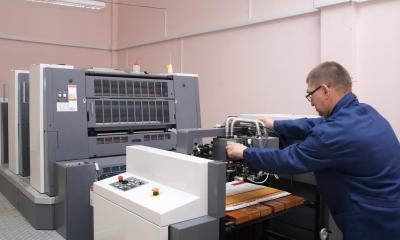
You'll need to be trained and experienced - in traditional and digital printing methods - if you want to set up as a commercial printer. Our practical guide will help you start up and run your own printing business.
- Research your target market
- Establish your customer profile
- Which printing services
- Buy an existing business
Research your target market
Estimating demand
It is very important to find out whether there will be a demand for the printing services you propose to offer.
If you are planning to target a local market you will need a 'pool' of potential customers to whom you can advertise your services. For example if your works will be located in a town or city there will be many businesses nearby who are likely to need printing services on a regular basis. In addition there will be local authorities, colleges and other organisations who may also be prepared to put work your way. Graphic design firms are often keen to build up a long term relationship with a reliable printer.
You could make up some samples of your work, together with a price list, and approach as many businesses as possible to let them know about your new business and the services you can provide. Bear in mind that many will probably already deal with a printing firm so it will be important to demonstrate to them that you can provide a superior service. You might, for example, have installed digital printing equipment that allows you to fulfil orders very quickly and to be able to offer short runs economically.
You could also contact businesses that provide help to start-ups - for example, accountancy practices - so that they pass your details on to new concerns that need letterheads and other business stationery.
Members of the public also want printing done from time to time, for example, personal stationery, wedding invitations, function tickets, raffle tickets and so on. If you want to attract this type of customer your premises will need to be located in an area that gets a lot of passing trade.
Think too about offering other services to customers, like website design and creation, or database services.
Remember, rather than trying to compete just on price, it is better for the profitability of your business if you can persuade customers to choose your firm because of the excellent service, reliability and quality that you offer. You might choose to stress that you offer papers from sustainable sources.
When you are showing your samples to your prospective customers, you could take the opportunity to discuss:
- the minimum value or volume that applies to orders (if any)
- what their requirements are likely to be - this would give you the opportunity to make contact with trade printers or finishers if necessary who could do work that you won't undertake in-house
- how frequently they are likely to require printing services
- how quickly they would want the order fulfilled
- whether they would welcome a delivery service
You could also ask them:
- what they think of your proposed services
- what they think of your pricing and terms
- whether they have any suggestions for improvements or enhancements to the service you have outlined to them
Your market research will help you to identify:
- whether your printing services are likely to be in demand
- the price that people would be prepared to pay for printed items
- the value of a typical order
To estimate your annual sales income think about how many customers you are likely to have and how much each of them will spend each time they place an order.
Research current trends, plus legal and tax issues
- Sector trends for printing businesses
- Legal issues for printing businesses
- VAT rules for printing businesses
Establish your customer profile
Your market
Your customer base will depend on which sector of the market you are targeting and which services you propose to provide. Your customers might include:
- local businesses and organisations
- other printers for whom you do outwork like finishing work
- graphic designers
- members of the public
If you offer web-to-print services your customers may come from all over the country.
Payment method
Many of your customers will settle their accounts with you by cheque, credit or debit card, but you might also receive payment direct to your bank account by BACS if you make regular supplies to a major customer. You might receive some payment in cash, for example for jobs that you do for members of the public. It's vital to make sure that you have good security systems in place if you handle cash regularly.
If you offer web-to-print services then you'll need either an internet merchant account to accept card payments online, or a third-party merchant account provider to process the payments for you.
Special offers and discounts
Because the printing industry is very competitive it's important to be aware that your larger customers in particular may want sizeable discounts from you in return for volume purchases and regular orders. They might expect you to throw in finishing work free of charge. Where you have long-standing contracts in place it's very important to monitor your costs at regular intervals to make sure that your profit margin is not being eroded by increases in wages, energy costs and the price of raw materials.
During periods of economic downturn major customers are also likely to insist on longer credit terms - for example 60 days instead of 30.
Customer service
Recent research has highlighted how important it is for printing businesses to provide excellent customer service to their clients. Print buyers want their printer to take an interest in their business and to help them make sure that things go smoothly. You can download various Best Practice studies from the BPIF Vision in Print website to help you to identify ways in which your business can improve the service it provides.
If your business achieves Forest Stewardship Council (FSC) Chain of Custody Certification because you use paper from well-managed sources, your customers can benefit from having this indicated on the paper products you print for them. This enhances their image as well as yours. You can find out more on the FSC website.
Which printing services
There are many different sub-sectors in the printing industry and firms generally specialise in a certain sector, for example, book or journal printing, carton printing, packaging work and so on, or offer the range of general printing services that are normally required by businesses and local organisations. For example letterheads, invoices, compliments slips, business cards, brochures and leaflets, envelopes, posters and tickets, NCR duplicate or triplicate pads, membership cards and so on. Don't overlook the growing number of businesses - like eBay and Amazon - that sell goods online. This type of business might be interested in a range of pre-printed mail boxes in different sizes. As a first step, decide on the nature of the work that you will accept so that you buy or lease the appropriate machinery.
Outwork
Many small printers put out some jobs or parts of jobs to other, specialist firms because they do not have the necessary skills, resources or machinery to undertake them. Examples of work that might be subcontracted out include graphic design, complex four colour jobs, wedding stationery and many finishing jobs such as stitching, binding, folding and so on. It is important that you establish a good working relationship with any firms that you put work out to so that you can rely on them to complete jobs to a high standard and on time. You also want their charges to be reasonable to allow you to make some profit on each job.
Quality standards
Whatever the nature of the printing services you will offer, it's important to be aware that the industry is very competitive and your customers are likely to demand high standards, low prices and quick turnaround times. You are unlikely to retain customers if the jobs you produce are late, contain errors, are badly printed or are carelessly packaged.
A first class service
Because there is keen competition in the printing industry it makes sense to do everything possible to make your business indispensable to your customers by providing them with a first class service as well as top quality printing. For example you could offer to store bulky print jobs for customers and to deliver as much as they need at periodic intervals. You could get in touch with customers every few months to make sure that their stocks of essential business stationery are not running low - as well as keeping that valuable contact with your customers this tactic may also help to prevent the last minute panic that puts you under pressure when businesses realise that they are about to run out of stock. Think also about ways in which you and your customers can make use of the internet to make things easier and more efficient for both of you.
It is worth being as proactive as possible with your customers and establishing with them from the outset how and when they want goods supplied. Having agreed this with them it must then be a priority to ensure that you meet their requirements.
Advertising your services
Whichever services you decide to offer, it's essential that your potential customers know about you.
There are a number of things you might do to promote your business:
- mailshot and send samples to local businesses and organisations
- leave leaflets with any organisations or firms (for example, accountancy practices) which advise new business start-ups. Most new businesses will need some printing done and it might be worth offering an introductory pack of basic business stationery
- advertise in local newspapers, trade journals, yearbooks and directories
- contact any local associations to announce your launch - possibly with an introductory offer
- sponsor local events
- create your own website - don't forget to highlight the fact if you use recycled or responsibly sourced papers
- use social media like Facebook and Twitter to display examples of recent projects and tell customers about special offers
- use telemarketing to contact potential customers
- send customers (and potential customers) useful items like calendars at Christmas time. Don't forget to print them with your contact details!
Buy an existing business
You might decide to buy an existing printing business rather than start your own venture from scratch. Buying a going concern can mean that the products, customers, regular sales, staff, premises and equipment are already in place.
Also consider the state of the premises, presses, equipment and so on. Pay particular attention to the printing presses and finishing equipment - remember that the move to digital printing technology means that traditional finishing equipment may not work well with digitally printed items
But buying a business can be a hazardous, expensive process unless you have the right skills and experience on your team, including legal and financial know-how. Establish the genuine trading and financial position, so that the price you pay for the business is not too high.



